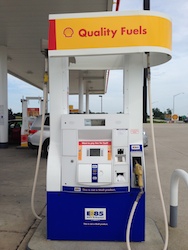According to new research from the Center for Agricultural and Rural Development (CARD), the 15 billion gallons per year of ethanol set in the Renewable Fuels Standard (RFS) is currently achievable. With infrastructure in place, what is needed, say the Iowa State University (ISU) economists, is the Environmental Protection Agency (EPA) to adhere to the law.
“Our results show that meeting the original 15 billion gallon RFS ethanol target in 2016 is feasible,” write ISU Profs. Bruce Babcock and Sebastien Pouliot. “The two key conditions needed to meet this consumption level are to allow the market for RINs [Renewable Identification Numbers] to work as intended, which will allow the price of E85 to fall to induce consumers to buy the fuel, and for EPA to set a consistent policy signal to industry that they will indeed have to meet this target. A clear and consistent message from EPA is needed to foster investment in fueling stations that will allow enough consumers to access E85.”
The data used was from actual daily fuel sales and volume prices from a major Midwest retail chain and demonstrates that E85 is a viable means to meet renewable fuel mandates. The study also reviewed the willingness of flex fuel vehicle (FFV) drivers to purchase E85 at various price points.
According to the report, “Using these new direct estimates of consumer demand, we find that owners of current flex vehicles in all US metro areas would consume 250 million gallons of E85 if it was priced at parity on a cost per mile basis with E10, and one billion gallons of ethanol if E85 were priced to save drivers 23% on a cost per mile basis. These estimates assume that no new E85 stations are installed,” write the authors. The study shows that in one metro area, the market share of E85 exceeded 15 percent when E85 saved FFV owners money on a cost-per-mile basis.
The authors also demonstrate how a strong and consistent enforcement signal from the EPA — transmitted through the market for RIN credits — can quickly transform the market for E85. They write, “Our finding that owners of FFVs like to save money on their fuel purchases is not too surprising: all of us do. Perhaps what is surprising is that EPA’s proposed decision to cut ethanol mandates reveals so little faith in their own compliance mechanism—the RIN trading system. …EPA set up the RIN trading system to create the incentive to invest in the infrastructure that is needed to expand the consumption of biofuels which, in turn, lowers RIN price. Using the power of the marketplace has proved to be an efficient method of achieving policy objectives.”
Renewable Fuels Association (RFA) President and CEO Bob Dinneen commented on the study’s findings, stating, “This report confirms that if EPA and the Administration would just let the RFS and its RIN mechanism work as intended, we would obliterate the so-called ‘blend wall’ and increase consumer access to lower-cost, lower-carbon renewable fuels that are made right here in America. The authors show that Congress’ original vision for conventional biofuels under the RFS is indeed achievable in 2016 with existing infrastructure, and that the only thing missing is the resolve and commitment from EPA and the Administration to continue building upon the remarkable success story that is the RFS.”


